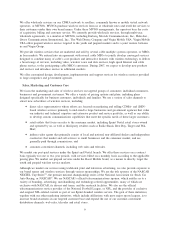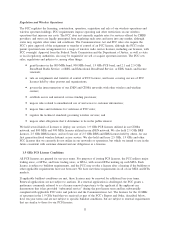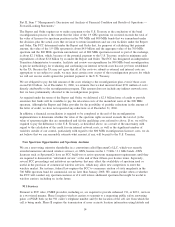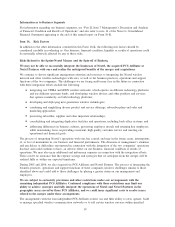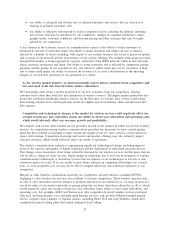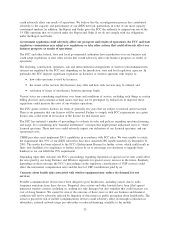Sprint - Nextel 2006 Annual Report Download - page 17
Download and view the complete annual report
Please find page 17 of the 2006 Sprint - Nextel annual report below. You can navigate through the pages in the report by either clicking on the pages listed below, or by using the keyword search tool below to find specific information within the annual report.longitude, and, with respect to our iDEN and CDMA network services, such information can be determined
only if the caller is using a handset with global positioning satellite, or GPS, capability. Implementation of
Phase I or Phase II E911 service must be completed within six months of a PSAP request for service in its
area, or longer, based on the agreement between the individual PSAP and carrier.
We were unable to satisfy the FCC requirement that 95% of our iDEN subscriber base have Assisted-GPS
capable handsets by December 31, 2005. The FCC recently denied our request for an extension of this
deadline and has referred the matter to the FCC’s Enforcement Bureau for further action. Although we have
asked the FCC to reconsider their decision, the FCC may impose fines, set new deadlines for compliance or
seek to require us to take actions to encourage our customers to upgrade their handsets so we can fulfill the
95% requirement.
Truth in Billing and Consumer Protection
The FCC’s Truth in Billing rules generally require CMRS licensees, such as us, to provide full and fair
disclosure of all charges on their wireless bills, including brief, clear, and non-misleading plain language
descriptions of the services provided. In response to a petition from the National Association of State Utility
Consumer Advocates, the FCC found that state regulation of CMRS rates, including line items on consumer
bills, is preempted by federal statute. This decision was overturned by the 11th Circuit Court of Appeals,
however, and many states continue to attempt to impose various regulations on the billing practices of wireless
carriers. The FCC is continuing to look at issues of consumer protection and the appropriate state and federal
roles. If states gain such authority, or there are other changes in the Truth in Billing rules, our billing and
customer service costs could increase.
Homeland Security
Homeland security issues are receiving attention at the FCC, from the states and in Congress. The FCC
chairman has created a new FCC bureau devoted to this area. We expect that increased scrutiny of wireless
carriers’ networks and several new initiatives could lead to new regulatory requirements regarding disaster
preparedness, network reliability, and communications among first responders. In October 2006, Congress
passed the Warning, Alert and Response Network Act, or WARN Act, which created a new voluntary wireless
emergency alert program. As a result of the WARN Act, the FCC created the Commercial Mobile Service
Alert Advisory Committee to recommend standards and protocols for delivery of emergency alerts to wireless
customers. We are unable to predict the impact of these initiatives on our business.
Tower Siting
Wireless systems must comply with various federal, state and local regulations that govern the siting, lighting
and construction of transmitter towers and antennas, including requirements imposed by the FCC and the
Federal Aviation Administration. FCC rules subject certain cell site locations to extensive zoning, environmen-
tal and historic preservation requirements and mandate consultation with various parties, including Native
Americans. The FCC adopted significant changes to its rules governing historic preservation review of
projects, which makes it more difficult and expensive to deploy antenna facilities. The FCC is also considering
changes to its rules regarding environmental protection as related to tower constructions, which, if adopted,
could make it more difficult to deploy facilities. To the extent governmental agencies impose additional
requirements on the tower siting process, the time and cost to construct cell towers could be negatively
impacted.
State and Local Regulation
While the Communications Act generally preempts state and local governments from regulating entry of, or
the rates charged by, wireless carriers, certain State PUCs and local governments regulate customer billing,
termination of service arrangements, advertising, certification of operation, use of handsets when driving,
service quality, sales practices, management of customer call records and protected information and many
other areas. Also, some state attorneys general have become more active in enforcing state consumer
15



